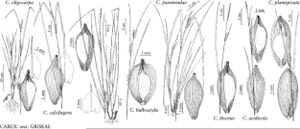Carex edwardsiana
Phytologia 67: 148, fig. 1. 1989.
Plants densely cespitose; rhizome internodes 0.2–6(–8) mm, 1.6–2.2 mm thick. Culms strongly purple-red to (3.7–)4.7–11.7 cm high at base, 6–34 cm; longest vegetative shoots (0.8–)1.4–4.4 times as long as longest culms. Leaves: sheaths glabrous; blades green, widest blades 2–3.6 mm wide, smooth abaxially. Inflorescences (0.88–)0.94–0.99 of culm height; peduncles of lateral spikes barely scaberulous or smooth; peduncles of terminal spikes 4.8–86 mm, barely to much exceeding lateral spikes; proximal bract sheaths tight, abaxially glabrous, sheath front apex concave or truncate; ligules 1–4.9(–9.6) mm; blades uniformly green, distal bract usually much exceeding terminal spike. Spikes 3–5, widely separate or distal 2–3 spikes overlapping, proximalmost spike basal; lateral spikes pistillate, with 2–8(–10) perigynia, (4–)9–17 × 3.6–6.9 mm, ratio of spike length (in mm) to flower number = 1.5–3.8; terminal spikes 19–34 × 1.6–2.9(–3.1) mm. Pistillate scales 1.8–6.3 × 1.4–2.1 mm, bodies 1.5–2.1(–2.5) mm, margins whitish, entire, apex with awn 0.3–4.5 mm or rarely awnless. Staminate scales 3.8–6 × 1.4–1.7 mm. Anthers 3.8–4.2 mm. Perigynia distichously imbricate, 51–67-veined, unwrinkled, narrowly obovoid-ellipsoid, obtusely triangular in cross section, 3.7–4.9 × 1.9–2.1(–2.3) mm, 1.7–2.4 times as long as wide, dull, base gradually tapered, apex abruptly contracted; beak straight, 0.3–0.7 mm. Achenes obovoid, 2.6–3.4 × 1.7–2.1 mm, tightly enveloped by perigynia; stipe straight, 0.1–0.6 mm; beak straight, 0.05–0.1(–0.15) mm.
Phenology: Fruiting spring.
Habitat: Dry-mesic decidous and deciduous-juniper woodlands in canyons and ravines, usually in clay loams very high in calcium on rocky banks and slopes just above streams and stream beds
Elevation: 300–500 m
Distribution

Tex.
Discussion
Carex edwardsiana is a local and uncommon endemic of central Texas. Most records are from the Balcones Canyonlands section of the Edwards Plateau. This species ranges the farthest southwest of any member of Carex sect. Griseae. In addition, its habitats are the driest of any species of the section. Carex edwardsiana usually grows near C. planostachys.
Selected References
None.
